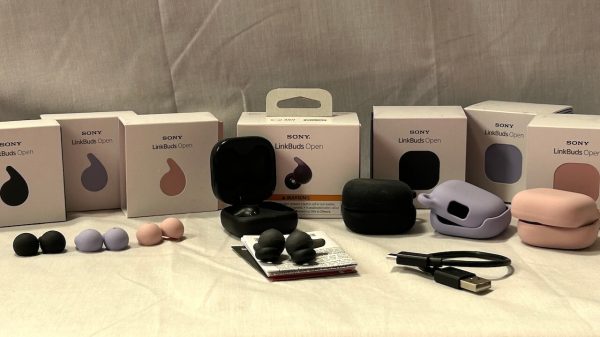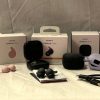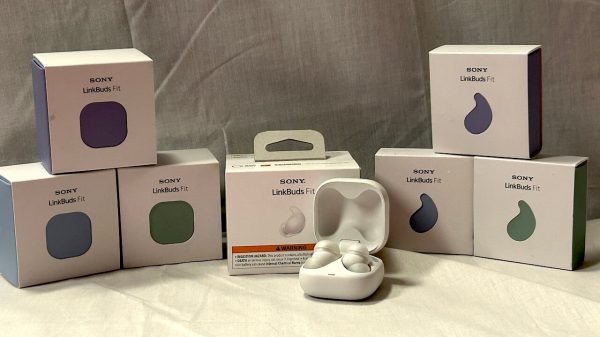Sennheiser isn’t the oldest or largest brand in headphones, but it is likely one of the most recognized worldwide. Founded in 1946, Sennheiser is credited with creating the first high-end headphone and has been an innovator in the space since the original HD series models were introduced. The Sennheiser CX True Wireless Earbuds are yet another milestone in the long history of the revered brand.
IEMs are a more recent addition to the line-up, but here again, Sennheiser created one of the first state-of-the-art models with the release of the IE800 in 2013. When the IE800 was introduced, one of the biggest complaints was that it had an impedance profile designed for portable use; at a time when there were very few DAPs or mobile devices capable of matching its sonic performance. The IE800 was a spectacular performer that was way ahead of the curve.
Fast forward to 2021 and we have portable sources that can take full advantage of the IE800 and its successor, the IE800s ($999 at Amazon). The issue for Sennheiser and every other brand heavily invested in wired headphones is that the vast majority of consumers want wireless earphones for their smart devices.
From a performance perspective, the wireless category is back in 2013 in comparison to portable DAPs and the best IEMs and earbuds currently available. Bluetooth aptX HD can’t deliver anything close to a high-end DAP from brands like Astell & Kern with high-end headphones.
All that being said, the wireless earbud category is far too large and lucrative for any brand to ignore. The future is now for brands like Sennheiser, Sony, and Master & Dynamic — which explains why all of them have invested so much in the category.
Sennheiser first entered the wireless market with the HD1 headband style IEM and has worked tirelessly to shrink the size of their products and improve the features set. Today, the Momentum True Wireless 2 ($229) occupies the top spot in their lineup, with the CX a step below and the CX 400BT ($99 at Amazon) occupying the entry level position.
The price point of the Sennheiser CX True Wireless is going to be very appealing for consumers. Retailing for $129.00 USD, the CX is designed to appeal to the mass market rather than targeting the high-end customer segment.
Audiophiles who dismiss the Sennheiser CX True Wireless because of its price should remember that the HD600 ($399 at Amazon) is the most popular headphone in the entire lineup and not the Orpheus. One thing Sennheiser has always understood is that customers like to start somewhere in the middle before taking the plunge to something more expensive.
The brand knows that the market is price sensitive with so much competition and that a lot of consumers will see a quality wireless earbud from Sennheiser for $129 and consider it to be a bargain.
Design Features

The CX are a mid-sized earpiece with a square outer shell that sits partially on the ear and partially in it. The inner shape is comfortable for long listening sessions once tip size is sorted out. Most of the outer face is touch sensitive which makes them easy to control but does mean that you need to handle them by the sides when inserting them in the ear to avoid accidentally changing settings.
The drivers are Sennheiser’s 7mm “True Response Transducer” which are the heart of most of their IEM models including the newly released IE300 and IE900. There are also a pair of beamforming microphones for making phone calls. The CX uses passive noise cancellation and doesn’t need the more sophisticated mic system of the Momentum TWS 2.
The upside is very few of the TWS models I have tested sound as good with ANC enabled as they do with it off so if you don’t really need ANC — you don’t have to sacrifice sound quality.
What the CX packs into the shell that the IE series doesn’t is a Bluetooth 5.2 chip set with AAC and aptX support and a 9 hour battery life. I found that battery life varied with the EQ settings and protocol used for connectivity but I always managed to get a full work day out of one charge.
The charging case can fully charge the buds twice before needing to find a USB Type-C connection. Charging times are quite quick with it requiring roughly 90 minutes to fully charge the buds. A quick charge of 15 minutes nets an hour worth of listening time for those in a great rush to get back to their music.
Reach Out and Touch Me
Like many of the TWS models available right now, there are a series of touch control options that take some getting used to in order to take full advantage of the CX.



Where it differs from a lot of the competition is the Smart Control app. The app is available from the Google Play and Apple stores and offers a lot of functionality including EQ presets, custom EQ settings, bass boost, the ability to customize the controls (tap sensors), firmware updates, and even an adjustment for sidetone (the amount of your own voice that is fed into the earphone during a phone conversation).
Sennheiser has obviously spent a lot of energy perfecting the app and it is easily the most complete and useful of those I’ve tested with only the Sony app coming close.



The Sound of Music
When it comes to sound quality, the Sennheiser CX differs substantially from the more expensive Momentum model; both models use similar drivers so the differences are interesting.
The CX starts with an emphasized sub-bass region that gradually drops back as it moves through the mid-bass and lower midrange. The midrange is mildly recessed as is the lower treble before the rest of the treble picks back up again and completes the V.
Roll-off is fairly steep above 12kHz which does limit air and sparkle slightly but not enough to make the CX feel closed-in or dull sounding.

The CX has good detail throughout and even with the bass emphasis, it manages to maintain a lot of texture in the midrange and treble.
This is a fun listen for classic rock, hip-hop, or electronic music. Tracks like Primal Scream’s “Rocks” and Keith Richards’ “Runnin’ Too Deep” have a nice balance between slam and rumble when called upon and vocal textures when the bass isn’t the star.
Mile Davis’ “Bitches Brew” shows off the well-rounded CX as it handles the horn section well with no overly harsh or bright notes at the top and enough body in the midrange to give everything some presence. Likewise, even string concertos sound acceptably realistic, although here the Momentum proves to be more tonally accurate offering more texture and better decay.

The place where most of the TWS models struggle is the recreation of the soundstage; it definitely sounds a bit shallow with a limited amount of height. The width is quite acceptable but the limited height makes full scale orchestral works sound more intimate than they should.
Conclusion
Remembering that these are a mid-point model and not the $299+ models that a lot of the competition are hawking brings the CX back into focus. At its price point, the Sennheiser CX is hard to beat for tonality and clarity in a TWS model. I’d go so far as to say I prefer the CX to the Apple Airpods (even the Pro model), and quite a few other models that cost a good bit more.
Factor in the battery life, build quality, tonality, and 2-year warranty from a company that has been making and servicing headphones for longer than the Head-Fi community have been alive — the $129 Sennheiser CX True Wireless Earbuds are a very compelling option.
Update: Since our original review, Sennheiser released the CX Plus. They are the same wireless earbuds with active noise cancellation (ANC). Find out if it’s worth the $50 upgrade in our Sennheiser CX Plus Review.
For more information: Sennheiser CX (sennheiser.com)
Where to buy: $129 at Amazon | Crutchfield
Related reading: Best Headphones





































